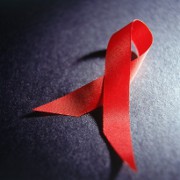 Photo: Getty Images
Photo: Getty Images
In the past three decades, HIV/AIDS has become a standard part of our vocabulary, our news reports and our preventive care efforts. We know the basics of how the disease is transmitted, what causes it and the how the virus changes over time.
We even know how to treat some of the symptoms and have managed to transform HIV from a death sentence to a chronic disease (in many populations).
But in the early 1980s when doctors began seeing a rise in the cases of previously rare conditions associated with poor immune systems, and scientists began to think that a new strain of disease could be the cause, none of this information existed.
Many panicked. Stigmas and rumors ran rampant. Medical resources and efforts were wasted.
In the face of emergent pharmaceutical necessities, the international community separated further into haves and have-nots.
So -- even though we have come a long way, it never hurts to review the basics of what HIV and AIDS truly are. Continuing to examine information about the origins and history, the causes and risk factors, and the symptoms and statistics of this relatively new disease will help to keep us safe, healthy and empowered.
HIV stands for Human Immunodeficiency Virus. This fancy name basically means that the virus affects a human’s immune system responses, crippling the defense a person normally has against infective agents and causing him/her to get sicker faster and more easily than a healthy peer.
This type of virus is also called a lentivirus, which literally translates to “slow virus” due to the long time period between infection and when any signs or symptoms of disease are apparent. The virus is able to “hide out” in the blood cells, remaining virtually undetectable and biding its time before attacking the immune system.
This latent nature of HIV is one of the factors that made the virus so difficult to understand. Because symptoms developed at a seemingly random time in the patient’s life, scientists and doctors were unable to determine how it was transmitted -- through skin contact? through the air? from an animal or insect? from food? -- making it especially frightening to care for.
Doctors worried that by touching or breathing the same air as their dying patients, they too would become infected.
Now of course, we know that HIV is transmitted through exchange of bodily fluids -- semen and vaginal fluids, blood, mucous, breast milk. The most likely vectors for infection are sexual intercourse (with either vaginal or anal penetration), shared needles, and mother-to-child transmission during pregnancy, delivery or breastfeeding.
Luckily, all these modes of transmission are preventable! By using condoms, knowing your sexual partner(s)’ history, getting tested regularly, making healthy lifestyle choices, avoiding drugs and never sharing needles, speaking with your doctor about preventing transmission during pregnancy and knowing the signs of HIV, you will be well on your way to staying safe and disease-free.
You cannot get HIV from kissing, hugging, sharing cups, shaking hands, coughing, sneezing, mosquitoes, public bathrooms or giving blood.
When HIV damages the white blood cells (the cells working for your immune system) so completely that they can no longer fight off any infections, the virus becomes an Acquired Immunodeficiency Syndrome (AIDS). This means that in some sense, AIDS is caused from HIV, though a more accurate portrayal of AIDS is that it is the manifestation of Human Immunodeficiency Virus in final stages.
A person has AIDS when the number of immune system cells in his/her body drop below a certain level. This means a patient can be diagnosed with AIDS, but with treatment, care, adequate nutrition and support, can return to a status of HIV infection levels.
However, while scientists have developed medication called antiretrovirals (ARVs), which help to protect or restore white blood cells in the body, there is no cure for AIDS. Due to its latent, long-term nature, the virus is able to mutate and become resistant to these ARVs, meaning that eventually a patient will succumb to the symptoms.
HIV and AIDS are extremely complex conditions that affect individuals, populations and systems. It has changed the way we look at risky behavior, population health and epidemic responses.
It is almost impossible to fit any sort of description of the disease into a single article ... so stay tuned for more information on the symptoms of both HIV and AIDS. And feel free to ask questions or share your own knowledge!
Sources:
AVERT; International HIV and AIDS Charity. (2011) "HIV and AIDS Topics." UK. www.avert.org
Centers for Disease Control and Prevention. (2011) "HIV/AIDS in the United States: An Overview." Department for Health and Human Services. www.cdc.gov/hiv
Reviewed September 27, 2011
by Michele Blackberg RN
Edited by Jody Smith






Add a Comment1 Comments
Since its discovery, AIDS has caused an estimated 36 million deaths worldwide (as of 2012). As of 2012, approximately 35.3 million people are living with HIV globally.
May 24, 2014 - 8:25amThis Comment